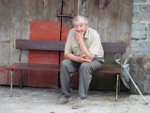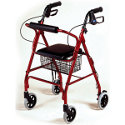An Introduction to Senior Fall Prevention
Published by Stephen on February 28, 2010 Under fall prevention There are a lot of factors that can increase the risk for a fall among the elderly, with senior falls often resulting in serious injuries and requiring hospitalization. Since the effects of these falls can be quite serious, learning how to help prevent them is very important.
There are a lot of factors that can increase the risk for a fall among the elderly, with senior falls often resulting in serious injuries and requiring hospitalization. Since the effects of these falls can be quite serious, learning how to help prevent them is very important.
What Makes Senior Falls so Serious?
Everyone falls from time to time. If you were to graph the frequency of falls over a persons entire life, it would likely resemble a reverse bell curve, with falls being very common as we are children and becoming less common as we move into adult hood. However, as we grow older, our senses begin to dull slightly.
This is a natural part of the aging process and doesn’t mean you loose intelligence when you grow older, but instead simply means that it takes longer to process the many singles sent throughout your body. The risk of developing diseases like arthritis and glaucoma is also much higher among the elderly, with these diseases making it much more difficult to get around. Osteoporosis is also common, with the disease causing the bones to become much more brittle and easier to fracture.
As a result of the natural way that the body ages, as well as the increased risk for diseases that affect mobility, the risk for a fall becomes much more common among seniors. Since the body is not able to respond as quickly to a fall, it is also more common for an injury to occur, especially among those with low bone density.
The above factors are all ones that increase the risk of a fall or of serious injury, with numerous studies finding that serious injuries are significantly harder to recover from among the elderly. In one study from last year, it was found that among those who have an injury, such as a broken hip, which requires hospitalization, the chance of dieing within the same year is much higher, with the need for moving to an assisted living community also increasing.
How Can Senior Falls Be Prevented?
 One of the most important aspects of preventing senior falls is making sure the living area of the senior is open and easy to get around. Objects, such as low coffee tables and throw rugs, which present tripping hazards should be removed and in general each area of the home should be accessible through a clear path. In addition to removing furniture that might increase the risk of a fall, it is also important to keep the living area clean, so, for instance, clothes or purses should never be left on the floor.
One of the most important aspects of preventing senior falls is making sure the living area of the senior is open and easy to get around. Objects, such as low coffee tables and throw rugs, which present tripping hazards should be removed and in general each area of the home should be accessible through a clear path. In addition to removing furniture that might increase the risk of a fall, it is also important to keep the living area clean, so, for instance, clothes or purses should never be left on the floor.
The bathroom is also a common source of injury among the elderly, in part because the floor is likely to become wet and very slippery. There are also a number of very hard surfaces, including the toilet, the wall of the bathtub, and even the floor in bathrooms that are tiled, making it much more likely that a fall in the bathroom will result in a serious injury.
To help make the bathroom safer, it is important to use non-skid water resistant mats, both in the bathroom and on the floor of the bathtub. Grab bars are also important and should be located around the toilet, sink, and shower area. In fact, it can be a good idea to replace all towel racks with grab bars, which ensures that there is no object on the wall that the senior can not grab for support.
Another important part of fall prevention is ensuring that the senior has a quality pair of shoes with a non-skid surface. Since many seniors lack the dexterity to tie their own shoes, it is common to use slippers, but if the senior can easily step out of the slipper or if the slipper is simply a cheap one from the local shopping center, it can increase the risk of an injury. Instead, it is important to invest in a quality set of shoes that can be easily used by the senior. Many opt for Velcro shoes, although there are a number of form fitting slide on shoes also available for the elderly.
Lighting is also important and all areas of the home, especially the stairs, should be well lit. Also, any area where there is a step down should be clearly marked.
When away from the home and often in the home itself, rollators, which are rolling walkers, should also be used. Rollators are similar to the traditional walker, but have wheels on the bottom so they can be pushed in front of the senior. Rollators also include brakes and many have a small bench that can provide a sturdy place to sit when waiting in line.
Senior falls are quite serious and injuries are significantly more difficult to recover from in the elderly. As a result, it is very important to make an effort to prevent these falls from occurring and help make the home a safer place.
No Comments |
Add a Comment